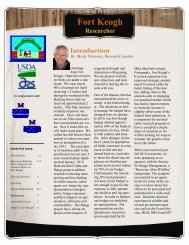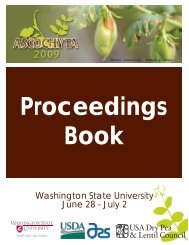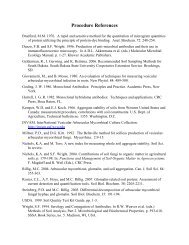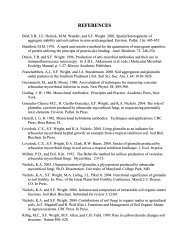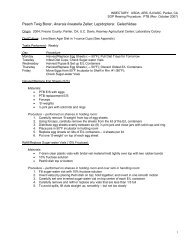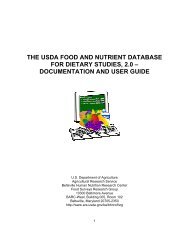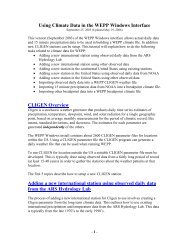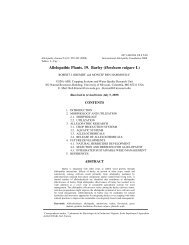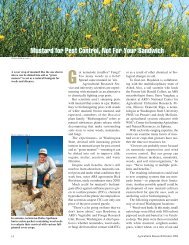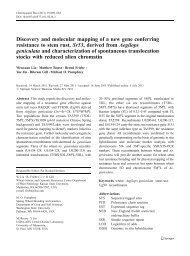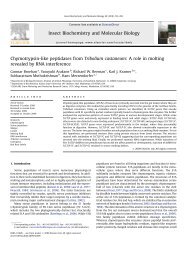Adjusting for forage variability via on-farm analysis
Adjusting for forage variability via on-farm analysis
Adjusting for forage variability via on-farm analysis
You also want an ePaper? Increase the reach of your titles
YUMPU automatically turns print PDFs into web optimized ePapers that Google loves.
Targeted feeding strategies:<br />
Accounting <str<strong>on</strong>g>for</str<strong>on</strong>g> <str<strong>on</strong>g>variability</str<strong>on</strong>g><br />
<str<strong>on</strong>g>Adjusting</str<strong>on</strong>g> <str<strong>on</strong>g>for</str<strong>on</strong>g> <str<strong>on</strong>g>for</str<strong>on</strong>g>age <str<strong>on</strong>g>variability</str<strong>on</strong>g><br />
<str<strong>on</strong>g>via</str<strong>on</strong>g> <strong>on</strong>-<strong>farm</strong> <strong>analysis</strong><br />
David Mertens<br />
Paolo Berzaghi
Introducti<strong>on</strong><br />
Forage compositi<strong>on</strong> has large <str<strong>on</strong>g>variability</str<strong>on</strong>g>,<br />
within the lot (Collins, 2000; St<strong>on</strong>e et<br />
al., 2003) and over time (Undersander et<br />
al., 2005);<br />
Variability in <str<strong>on</strong>g>for</str<strong>on</strong>g>ages is unavoidable, but<br />
can be managed using sampling<br />
protocols (St. Pierre and Cobanov,<br />
2007) and adequate analytical tools<br />
(Near infrared)<br />
Getting More from Forages – July 29-30, 2009
Forage <str<strong>on</strong>g>variability</str<strong>on</strong>g>: hay<br />
C<strong>on</strong>stituent AVG SD<br />
Btwn<br />
bales<br />
Min - max<br />
Btwn bales<br />
Getting More from Forages – July 29-30, 2009<br />
SD<br />
W/in<br />
bales<br />
NDF 40.2 2.0 36.3 – 44.1 2.1<br />
CP 17.2 0.8 15.7 – 18.7 0.8<br />
Collins, 2000
Haylage NDF – Sampling and Laboratory<br />
C<strong>on</strong>sistency Evaluati<strong>on</strong><br />
43.3<br />
44.4<br />
45.7<br />
40.7<br />
41.0<br />
41.8<br />
36.0<br />
36.3<br />
37.8<br />
43.3<br />
43.6<br />
43.7<br />
41.6<br />
42.9<br />
43.0<br />
36.4<br />
37.7<br />
37.9<br />
Getting More from Forages – July 29-30, 2009<br />
St<strong>on</strong>e, 2004
Variati<strong>on</strong> in <str<strong>on</strong>g>for</str<strong>on</strong>g>ages over time<br />
50<br />
45<br />
40<br />
35<br />
30<br />
25<br />
(modified<br />
DM,% Changes<br />
in DM c<strong>on</strong>tent<br />
of Alfalfa<br />
haylage<br />
20<br />
28-May 17-Jul 5-Sep 25-Oct 14-Dec 2-Feb<br />
from<br />
Undersander et al., 2005)<br />
Time<br />
Getting More from Forages – July 29-30, 2009<br />
–<br />
USDFRC Praire<br />
du<br />
Sac
Variati<strong>on</strong> in <str<strong>on</strong>g>for</str<strong>on</strong>g>ages over time<br />
%<br />
Changes in Moisture c<strong>on</strong>tent of Alfalfa silage –<br />
USDFRC Praire du Sac July 18-August 22 2006<br />
80<br />
75<br />
70<br />
65<br />
60<br />
55<br />
50<br />
45<br />
7/18/2006<br />
57<br />
69<br />
77<br />
67<br />
7/25/2006<br />
ALFALFA SILAGE<br />
69 67<br />
52<br />
65 66 64 66 66<br />
8/1/2006<br />
8/8/2006<br />
8/15/2006<br />
Getting More from Forages – July 29-30, 2009<br />
Bag5-04<br />
Linear trend<br />
59 6061<br />
51<br />
8/22/2006<br />
50<br />
56
Variati<strong>on</strong> in <str<strong>on</strong>g>for</str<strong>on</strong>g>ages over time<br />
%<br />
Changes in Moisture c<strong>on</strong>tent of Corn silages –<br />
USDFRC Praire du Sac July 18-August 22 2006<br />
80<br />
75<br />
70<br />
65<br />
60<br />
55<br />
50<br />
7/18/2006<br />
CORN SILAGES<br />
74<br />
73<br />
70<br />
69<br />
68 68<br />
71<br />
69<br />
71<br />
69<br />
68<br />
70<br />
68<br />
67<br />
7/25/2006<br />
8/1/2006<br />
8/8/2006<br />
8/15/2006<br />
Getting More from Forages – July 29-30, 2009<br />
August 18th - Rain<br />
78<br />
8/22/2006<br />
69 68<br />
B4
Effect of rain (20mm) <strong>on</strong> a 50% DM Forage<br />
In 2008 in Dane county there were 27 rain events averaging about 20mm of rain<br />
1200<br />
1000<br />
800<br />
600<br />
400<br />
200<br />
0<br />
Rain<br />
Forage Forage + rain<br />
DM Water<br />
100%<br />
90%<br />
80%<br />
70%<br />
60%<br />
50%<br />
40%<br />
30%<br />
20%<br />
10%<br />
0%<br />
Getting More from Forages – July 29-30, 2009<br />
50% DM 43.1% DM<br />
Forage Forage +<br />
rain<br />
DM Water
Effect of rain (20mm) <strong>on</strong> a 30% DM Forage<br />
In 2008 in Dane county there were 27 rain events averaging about 20mm of rain<br />
1200<br />
1000<br />
800<br />
600<br />
400<br />
200<br />
0<br />
Rain<br />
Forage Forage + rain<br />
DM Water<br />
100%<br />
90%<br />
80%<br />
70%<br />
60%<br />
50%<br />
40%<br />
30%<br />
20%<br />
10%<br />
0%<br />
Getting More from Forages – July 29-30, 2009<br />
30% DM 25.9% DM<br />
Forage Forage +<br />
rain<br />
DM Water
Effects of <str<strong>on</strong>g>for</str<strong>on</strong>g>age DM changes<br />
Feed kg/d<br />
Corn Silage 26.0<br />
Grass hay 2.0<br />
HMC 3.0<br />
Ground Corn 2.0<br />
Cott<strong>on</strong> seed 1.5<br />
SBM 3.0<br />
Extr. Soy 1.5<br />
Prot-min-vit<br />
c<strong>on</strong>c. 2.5<br />
Water 2.0<br />
Chem. Comp CS DM<br />
38% 32%<br />
As is, kg 43.5 43.5<br />
DM, kg 23.1 21.5<br />
DM, % 53.1 49.5<br />
CP, % 16.4 17.1<br />
NDF% 30.9 29.9<br />
Starch,% 26.4 26.0<br />
EE% 4.9 5.1<br />
ASH% 8.6 8.5<br />
1Milk. Kg/d 40.5 38.5<br />
1 Predicted by the Dairy NRC 2001<br />
Getting More from Forages – July 29-30, 2009
Effects of Feed Variability<br />
Animal per<str<strong>on</strong>g>for</str<strong>on</strong>g>mance<br />
Animal health<br />
Excreti<strong>on</strong> of nutrients<br />
Farm profitability<br />
Managing feed <str<strong>on</strong>g>variability</str<strong>on</strong>g>:<br />
is worth $0.27/cow/day<br />
or about 1kg of milk/d<br />
Getting More from Forages – July 29-30, 2009<br />
(St-Pierre, 2006)
Value of <strong>analysis</strong>: a <strong>farm</strong> experience<br />
•Frequent adjustments would result<br />
productivity (value per 100 cows):<br />
•1095 $/yr<br />
•2190 $/yr<br />
•1095 $/yr<br />
Getting More from Forages – July 29-30, 2009<br />
in an<br />
increase<br />
with the determinati<strong>on</strong> of DM;<br />
with chem. <strong>analysis</strong> of <str<strong>on</strong>g>for</str<strong>on</strong>g>ages;<br />
with complete <strong>analysis</strong> of c<strong>on</strong>centrates;<br />
•TOTAL $4380 gained<br />
per year<br />
(Tylutki<br />
<str<strong>on</strong>g>for</str<strong>on</strong>g><br />
100 cows<br />
et al. 2002)<br />
in
Why do we need to feed cows<br />
precisely every day?<br />
High producing cows are fed a very<br />
narrow range in diets<br />
• The c<strong>on</strong>flict between high nutrient demand<br />
and minimum fiber requirements means<br />
that dairy rati<strong>on</strong>s are finely tuned<br />
(balanced) to meet numerous nutrient<br />
requirements<br />
Getting More from Forages – July 29-30, 2009
DM Intake (% BW/d)<br />
5<br />
4<br />
3<br />
2<br />
1<br />
NDF-Energy Intake System<br />
Rati<strong>on</strong> opti<strong>on</strong>s decrease<br />
as milk producti<strong>on</strong> increases<br />
0<br />
15 20 25 30 35 40 45 50 55 60<br />
Rati<strong>on</strong> NDF (% DM)<br />
Getting More from Forages – July 29-30, 2009<br />
Too little fiber<br />
Feasible rati<strong>on</strong><br />
Too much fiber<br />
20 kg FCM/d<br />
30 kg FCM/d<br />
40 kg FCM/d<br />
50 kg FCM/d
Why do we need to feed cows<br />
precisely every day?<br />
High producing cows are fed a very<br />
narrow range in diets<br />
• Like a race car – everything is tuned <str<strong>on</strong>g>for</str<strong>on</strong>g><br />
maximum power and tracti<strong>on</strong> – change<br />
anything (blown tire) and disaster<br />
happens!<br />
Getting More from Forages – July 29-30, 2009
Classical Dose-Resp<strong>on</strong>se<br />
Per<str<strong>on</strong>g>for</str<strong>on</strong>g>mance<br />
50<br />
40<br />
30<br />
20<br />
10<br />
0<br />
Safety<br />
factor<br />
0 10 20 30 40 50 60<br />
Level of Nutrient<br />
Getting More from Forages – July 29-30, 2009<br />
Isn’t this rati<strong>on</strong> is<br />
GREAT!
Why do we need to feed cows<br />
precisely every day?<br />
Difficult to over-<str<strong>on</strong>g>for</str<strong>on</strong>g>mulate rati<strong>on</strong>s like we<br />
did in the past<br />
• Can’t maintain balance of nutrients in<br />
rati<strong>on</strong>s <str<strong>on</strong>g>for</str<strong>on</strong>g> high producti<strong>on</strong><br />
� Putting in <strong>on</strong>e nutrient in excess requires the<br />
removal of another required nutrient<br />
• Envir<strong>on</strong>mental c<strong>on</strong>cerns related to<br />
excessive nutrient excreti<strong>on</strong><br />
Getting More from Forages – July 29-30, 2009
Classical Dose-Resp<strong>on</strong>se<br />
Per<str<strong>on</strong>g>for</str<strong>on</strong>g>mance<br />
50<br />
40<br />
30<br />
20<br />
10<br />
0<br />
0 10 20 30 40 50 60<br />
Level of Nutrient<br />
Getting More from Forages – July 29-30, 2009<br />
I sure hope they know<br />
what they are doing!
Feed Quality C<strong>on</strong>trol Program<br />
• Requires<br />
• Frequent sampling<br />
• Rapid return of results<br />
• Accurate analytical method<br />
• Simple to implement<br />
• Low cost<br />
Getting More from Forages – July 29-30, 2009
NIRS Opti<strong>on</strong>s<br />
• Laboratory instruments<br />
• M<strong>on</strong>ochromators (grating instruments)<br />
• Interferometers (Fourier Trans<str<strong>on</strong>g>for</str<strong>on</strong>g>m – FT)<br />
• Portable sensors<br />
• Diode arrays<br />
Getting More from Forages – July 29-30, 2009
Slit - m<strong>on</strong>ochromator systems<br />
Grating<br />
light<br />
Detectors Reference (White)<br />
Mirror<br />
Getting More from Forages – July 29-30, 2009<br />
•Moving parts<br />
•Pre-dispersive<br />
•PbS or InGaAs detectors<br />
•Slow scanning (1 sec)<br />
•Highly accurate<br />
•400-1098; 1100-2498nm<br />
•Every 2nm
Laboratory Instruments<br />
Getting More from Forages – July 29-30, 2009
Water peaks<br />
Getting More from Forages – July 29-30, 2009<br />
Undried Unground<br />
Dried Unground<br />
Dried Ground
Diode Array<br />
• No moving parts<br />
• Post-dispersive<br />
• 800-1100nm<br />
•Silic<strong>on</strong> detector (low cost)<br />
• 900-1700nm<br />
InGaAs detector (expensive)<br />
• Fast scanning (10 ms)<br />
• Very accurate<br />
Getting More from Forages – July 29-30, 2009
Diode Array Sensors<br />
Getting More from Forages – July 29-30, 2009
Water Has a Str<strong>on</strong>g NIR Absorbance<br />
Spectral changes of a <str<strong>on</strong>g>for</str<strong>on</strong>g>age during drying<br />
Getting More from Forages – July 29-30, 2009
M<strong>on</strong>ochromator vs Diode array<br />
M<strong>on</strong>ochromator<br />
Lab bench instrument<br />
Dedicated (sample<br />
presentati<strong>on</strong> not<br />
modifiable)<br />
Expensive (35-50K<br />
USD)<br />
Good equati<strong>on</strong><br />
transferability<br />
Getting More from Forages – July 29-30, 2009<br />
Diode arrays<br />
Rugged instrument<br />
Sample presentati<strong>on</strong><br />
more flexible<br />
Less expensive (15-35K<br />
USD)<br />
Equati<strong>on</strong> transferability<br />
is more difficult
Objectives<br />
Develop rapid <strong>on</strong>-<strong>farm</strong> DM method of<br />
<strong>analysis</strong> based <strong>on</strong> diode array near<br />
infrared sensors<br />
M<strong>on</strong>itor <str<strong>on</strong>g>for</str<strong>on</strong>g>ages and TMR compositi<strong>on</strong><br />
overtime<br />
Evaluate effects of single day changes in<br />
feed compositi<strong>on</strong> and feed allowance<br />
<strong>on</strong> milk producti<strong>on</strong><br />
Getting More from Forages – July 29-30, 2009
Materials and Methods<br />
10 weeks: 8 experimental wks + 2 wks of rest<br />
Daily sampling of <str<strong>on</strong>g>for</str<strong>on</strong>g>ages (corn and alfalfa<br />
silages) and TMRs;<br />
Weekly sampling of c<strong>on</strong>centrates;<br />
Immediately after collecti<strong>on</strong>, <str<strong>on</strong>g>for</str<strong>on</strong>g>age samples<br />
were scanned in duplicate using a diode<br />
array sensor (HarvestLab TM , Deere &<br />
Company);<br />
In-house DM calibrati<strong>on</strong> <str<strong>on</strong>g>for</str<strong>on</strong>g> the sensor was<br />
developed with Unscrambler 9.7:<br />
• SECV=2.2 % R 2 =0.95<br />
Getting More from Forages – July 29-30, 2009
Large Range, Multi-Product Calibrati<strong>on</strong><br />
Getting More from Forages – July 29-30, 2009
John Deere HarvestLab TM<br />
•Diode array w/ 128 diodes<br />
•Range 960-1550nm<br />
•Fast scanning (11.5 ms)<br />
•Internal reference<br />
Getting More from Forages – July 29-30, 2009<br />
•Large glass bowl (200 mm)<br />
•Spinning bowl<br />
•5s scan per bowl<br />
•Disclaimer – in<str<strong>on</strong>g>for</str<strong>on</strong>g>mati<strong>on</strong> provided<br />
<str<strong>on</strong>g>for</str<strong>on</strong>g> descripti<strong>on</strong> <strong>on</strong>ly
Material and Methods<br />
After scanning, samples were dried (55 °C),<br />
ground (1mm Wiley), and scanned <strong>on</strong> a Foss<br />
6500 grating m<strong>on</strong>ochromator NIRS (Foss<br />
NorthAmerica);<br />
Forages and TMR analyzed by NIRS using an<br />
updated (30 samples) in-house (USDFRC)<br />
calibrati<strong>on</strong> equati<strong>on</strong>:<br />
• aNDFom SECV = 0.89%DM R2 = 0.99<br />
• CP SECV = 0.42%DM R2 = 0.99<br />
Weekly samples of c<strong>on</strong>centrates were analyzed<br />
by AOAC Official Methods<br />
Getting More from Forages – July 29-30, 2009
Material and Methods<br />
48 cows (selected to represent a typical herd<br />
distributi<strong>on</strong>)<br />
• Parity = 2.3±1.1<br />
• Days-in-lactati<strong>on</strong> = 138 ±52<br />
• Body weight = 592 ±63kg<br />
Blocked by parity and DIM and assigned to<br />
either a C<strong>on</strong>trol or a Treatment (TRT) group;<br />
C<strong>on</strong>trol: TMR adjusted <str<strong>on</strong>g>for</str<strong>on</strong>g> <str<strong>on</strong>g>for</str<strong>on</strong>g>age DM changes<br />
daily using an exp<strong>on</strong>ential moving average<br />
Treatment: Forage DM changed <strong>on</strong>e day per<br />
experimental week<br />
Getting More from Forages – July 29-30, 2009
Ingredient Compositi<strong>on</strong> of the TMR<br />
Ingredient % of DM<br />
Alfalfa Silage 27.00<br />
bmr Corn silage 25.00<br />
HMCorn 28.00<br />
Roasted SB 10.00<br />
SBM, 48% 2.50<br />
Distillers grains 5.00<br />
Blood meal 1.00<br />
LactoMin a 1.50<br />
Getting More from Forages – July 29-30, 2009
Experimental week<br />
BASELINE CHG RECOVERY<br />
d1 d2 d3 d4 d5 d6 d7<br />
BASELINE – ad-lib. (110% of intake)<br />
Change (CHG) – ⇓ offered feed or <str<strong>on</strong>g>for</str<strong>on</strong>g>age DM<br />
chg<br />
RECOVERY – ad-lib. (110% of intake)<br />
Getting More from Forages – July 29-30, 2009
Treatments<br />
During the Day of Change<br />
• Experimental rati<strong>on</strong> with feed reduced to 88%<br />
• Reduce the DM of CS & AS by 8%-units by adding<br />
water (repeated)<br />
• Diet equal to Trt 2 without adding the water<br />
• Reduce DM of CS <strong>on</strong>ly by 16%-units by adding water<br />
(repeated)<br />
• Reduce DM of AS <strong>on</strong>ly by 16%-units by adding water<br />
• Reduce the DM of CS & AS by 16%-units by adding<br />
water<br />
Getting More from Forages – July 29-30, 2009
Materials and Methods<br />
Cows were fed individually <strong>on</strong>ce a day<br />
Feed offered and refusals were measured<br />
daily<br />
Milking 2X<br />
Milk samples at each milking <strong>on</strong> d2-d6<br />
Intake and milk producti<strong>on</strong> expressed as<br />
difference from baseline (d2 and d3)<br />
Proc Mix with Cow as random variable<br />
within Block X Treatment group;<br />
Getting More from Forages – July 29-30, 2009
Variati<strong>on</strong> in DM c<strong>on</strong>tent<br />
of corn silage<br />
DM, %<br />
34.0<br />
33.0<br />
32.0<br />
31.0<br />
30.0<br />
29.0<br />
28.0<br />
AVG= 31.4 % ; SD= 0.74<br />
1 8 15 22 29 36 43 50 57 64<br />
DM Rain_snow<br />
Getting More from Forages – July 29-30, 2009
Variati<strong>on</strong> in DM c<strong>on</strong>tent of<br />
alfalfa silage<br />
DM, %<br />
48.0<br />
43.0<br />
38.0<br />
33.0<br />
28.0<br />
AVG= 41.0 % ; SD= 3.04<br />
1 8 15 22 29 36 43 50 57 64<br />
Date<br />
DM Rain or snow<br />
Getting More from Forages – July 29-30, 2009
DM, %<br />
Variati<strong>on</strong> in DM c<strong>on</strong>tent of TMR<br />
60<br />
55<br />
50<br />
45<br />
40<br />
35<br />
30<br />
1 4 7 10 13 16 19 22 25 28 31 34 37 40 43 46 49 52 55<br />
TRT CON chg day<br />
Getting More from Forages – July 29-30, 2009
Variati<strong>on</strong> in aNDFom c<strong>on</strong>tent of TMR<br />
aNDFom, % DM<br />
32<br />
30<br />
28<br />
26<br />
24<br />
22<br />
20<br />
1 4 7 10 13 16 19 22 25 28 31 34 37 40 43 46 49 52 55<br />
CON TRT Chg day<br />
Getting More from Forages – July 29-30, 2009
Stats of Compositi<strong>on</strong><br />
n AVG SDEV Min max<br />
AS DM, % 68 41.0 3.04 32.4 47.3<br />
AS aNDFom, %DM 53 37.0 2.30 32.7 41.0<br />
AS CP, %DM 53 22.0 1.25 19.4 24.2<br />
CS DM, % 68 31.4 0.74 28.9 33.0<br />
CS aNDFom, %DM 50 40.4 1.77 37.0 44.7<br />
CS CP, %DM 50 7.8 0.26 7.3 8.3<br />
TMR_CON DM, % 55 48.5 1.33 44.8 50.9<br />
TMR_CON aNDFom, %DM 55 27.5 1.13 25.7 30.7<br />
TMR_CON CP, %DM 55 17.0 0.62 15.6 18.6<br />
TMR_TRT DM, % 55 47.7 2.58 37.9 51.1<br />
TMR_TRT aNDFom, %DM 52 27.1 1.78 21.8 30.5<br />
TMR_TRT CP, %DM 52 17.0 0.68 15.6 19.3<br />
Getting More from Forages – July 29-30, 2009
Changes in DM Intake: by TRT<br />
DMI, kg/d<br />
29<br />
28<br />
27<br />
26<br />
25<br />
24<br />
23<br />
22<br />
21<br />
20<br />
19<br />
Baseline<br />
CHG<br />
Getting More from Forages – July 29-30, 2009<br />
Recovery<br />
TRT*PER*WK P
DMI, kg/d<br />
Changes in DM Intake<br />
relative to baseline<br />
1.0<br />
0.5<br />
0.0<br />
-0.5<br />
-1.0<br />
-1.5<br />
-2.0<br />
-2.5<br />
TRT*PER P
Changes in milk fat<br />
relative to baseline<br />
Fat, %<br />
0.10<br />
0.05<br />
0.00<br />
-0.05<br />
-0.10<br />
-0.15<br />
-0.20<br />
Treatment NS<br />
day NS<br />
Baseline Rec_d5 Rec_d6<br />
Getting More from Forages – July 29-30, 2009<br />
CON<br />
TRT
Changes in milk protein<br />
relative to baseline<br />
Protein, %<br />
0.10<br />
0.08<br />
0.06<br />
0.04<br />
0.02<br />
0.00<br />
-0.02<br />
-0.04<br />
-0.06<br />
-0.08<br />
-0.10<br />
Treatment NS<br />
day P
Changes in Milk Yield<br />
relative to baseline<br />
Milk, kg/d<br />
1.0<br />
0.5<br />
0.0<br />
-0.5<br />
-1.0<br />
-1.5<br />
Treatment P
C<strong>on</strong>clusi<strong>on</strong>s<br />
Day to day DM variati<strong>on</strong> in <str<strong>on</strong>g>for</str<strong>on</strong>g>ages is<br />
unavoidable and can be large<br />
On-<strong>farm</strong>, rapid methods of <strong>analysis</strong><br />
based <strong>on</strong> rugged NIR instruments can<br />
help managing such variati<strong>on</strong><br />
Use of these instruments must also<br />
c<strong>on</strong>sider integrati<strong>on</strong> of feed<br />
compositi<strong>on</strong> with feed mixing software<br />
(i.e. EZfeed, Feedwatch,……)<br />
Getting More from Forages – July 29-30, 2009
Cycle of Feeding<br />
What rati<strong>on</strong> is the cow really getting?<br />
DM<br />
Assay<br />
Feed DM<br />
amounts<br />
Farmer’s<br />
rati<strong>on</strong><br />
Feed as-fed<br />
amounts<br />
Feeder’s<br />
mixed rati<strong>on</strong><br />
Nutriti<strong>on</strong>ist’s<br />
rati<strong>on</strong><br />
Cow’s<br />
diet<br />
Silage<br />
Feeds<br />
Getting More from Forages – July 29-30, 2009<br />
Nutrients<br />
Required<br />
Lab<br />
Analysis<br />
Milk & Meat<br />
Manure
C<strong>on</strong>clusi<strong>on</strong>s<br />
Single day variati<strong>on</strong>s in <str<strong>on</strong>g>for</str<strong>on</strong>g>age<br />
compositi<strong>on</strong> have an immediate effect<br />
<strong>on</strong> DM intake;<br />
For decrease in DMI of <strong>on</strong>e kg in a single<br />
day, 0.8 kg of milk is lost in each of the<br />
following two days<br />
Other detrimental effects of <str<strong>on</strong>g>for</str<strong>on</strong>g>age<br />
variati<strong>on</strong> not accounted in this trial<br />
include animal health and nutrient<br />
excreti<strong>on</strong><br />
Getting More from Forages – July 29-30, 2009
Targeted feeding strategies:<br />
Accounting <str<strong>on</strong>g>for</str<strong>on</strong>g> <str<strong>on</strong>g>variability</str<strong>on</strong>g><br />
<str<strong>on</strong>g>Adjusting</str<strong>on</strong>g> <str<strong>on</strong>g>for</str<strong>on</strong>g> <str<strong>on</strong>g>for</str<strong>on</strong>g>age <str<strong>on</strong>g>variability</str<strong>on</strong>g><br />
Questi<strong>on</strong>s?<br />
<str<strong>on</strong>g>via</str<strong>on</strong>g> <strong>on</strong>-<strong>farm</strong> <strong>analysis</strong><br />
David Mertens<br />
Paolo Berzaghi



